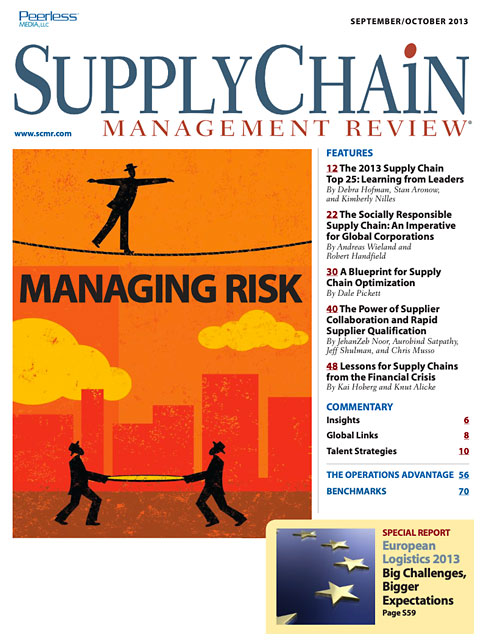Sorry, but your login has failed. Please recheck your login information and resubmit. If your subscription has expired, renew here.
September-October 2013
The 2013 ranking of supply chain leaders from Gartner highlights the best of the best—large, global companies that are furthest along on the journey toward demand-driven supply chains. While the mix of companies is diverse, there are lessons to be learned from these supply chain leaders. Browse this issue archive.Need Help? Contact customer service 847-559-7581 More options
On April 24, 2013, the deadliest garment factory incident in history occurred when the Rana Plaza manufacturing plant collapsed in Savar, Bangladesh, near the capital city of Dhaka, killing more than 1,120 people. This incident occurred just five months after another fire at a garment plant in Dhaka killed more than 100 people. That facility was operated by Tazreen Fashions Ltd. and produced sweater jackets for C&A, shorts for Walmart, and lingerie for Sears.
Had these incidents not occurred (See Table 1), these enterprises would be considered textbook cases for highly efficient global supply chains. In today’s market, supply chains compete against supply chains, global brands concentrate on their core competency (marketing activities) and suppliers in Bangladesh offer high flexibility and cheap labor costs. This has allowed global brands to create extremely responsive supply chains and bring lower priced apparel to store shelves. Further, the time to design and delivery of new garments to the market has been reduced from more than one year to just a few weeks.
More efficient processes, cheaper products, and happier consumers appear to be a winning combination. Yet something is wrong with this picture. As these cases demonstrate, best practice supply chain thinking seems to have overlooked the social aspects of running a global supply chain. Disasters such as these put companies at risk of damaging their reputations and tarnishing their brands. The recent incidents, for instance, led to rallies and protests against Walmart, Gap, Loblaws, and other retailers that are purchasing from these sources.
 |
This complete article is available to subscribers
only. Click on Log In Now at the top of this article for full access. Or, Start your PLUS+ subscription for instant access. |
Not ready to subscribe, but need this article?
Buy the complete article now. Only $20.00. Instant PDF Download.
Access the complete issue of Supply Chain Management Review magazine featuring
this article including every word, chart and table exactly as it appeared in the magazine.
SC
MR
Sorry, but your login has failed. Please recheck your login information and resubmit. If your subscription has expired, renew here.
September-October 2013
The 2013 ranking of supply chain leaders from Gartner highlights the best of the best—large, global companies that are furthest along on the journey toward demand-driven supply chains. While the mix of companies is… Browse this issue archive. Access your online digital edition. Download a PDF file of the September-October 2013 issue.
 |
Download Article PDF |
On April 24, 2013, the deadliest garment factory incident in history occurred when the Rana Plaza manufacturing plant collapsed in Savar, Bangladesh, near the capital city of Dhaka, killing more than 1,120 people. This incident occurred just five months after another fire at a garment plant in Dhaka killed more than 100 people. That facility was operated by Tazreen Fashions Ltd. and produced sweater jackets for C&A, shorts for Walmart, and lingerie for Sears.
Had these incidents not occurred (See Table 1), these enterprises would be considered textbook cases for highly efficient global supply chains. In today’s market, supply chains compete against supply chains, global brands concentrate on their core competency (marketing activities) and suppliers in Bangladesh offer high flexibility and cheap labor costs. This has allowed global brands to create extremely responsive supply chains and bring lower priced apparel to store shelves. Further, the time to design and delivery of new garments to the market has been reduced from more than one year to just a few weeks.
More efficient processes, cheaper products, and happier consumers appear to be a winning combination. Yet something is wrong with this picture. As these cases demonstrate, best practice supply chain thinking seems to have overlooked the social aspects of running a global supply chain. Disasters such as these put companies at risk of damaging their reputations and tarnishing their brands. The recent incidents, for instance, led to rallies and protests against Walmart, Gap, Loblaws, and other retailers that are purchasing from these sources.
 |
SUBSCRIBERS: Click here to download PDF of the full article. |
SC
MR

Latest Supply Chain News
- Tech investments bring revenue increases, survey finds
- Survey reveals strategies for addressing supply chain, logistics labor shortages
- Israel, Ukraine aid package to increase pressure on aerospace and defense supply chains
- How CPG brands can deliver on supplier diversity promises
- How S&OP provides the answer to in-demand products
- More News
Latest Resources

 Explore
Explore
Latest Supply Chain News
- Tech investments bring revenue increases, survey finds
- Survey reveals strategies for addressing supply chain, logistics labor shortages
- Israel, Ukraine aid package to increase pressure on aerospace and defense supply chains
- How CPG brands can deliver on supplier diversity promises
- How S&OP provides the answer to in-demand products
- AI, virtual reality is bringing experiential learning into the modern age
- More latest news
Latest Resources

Subscribe

Supply Chain Management Review delivers the best industry content.

Editors’ Picks





